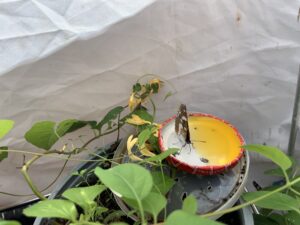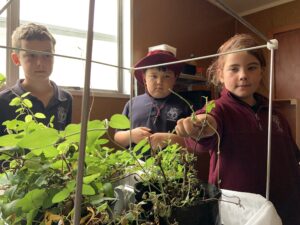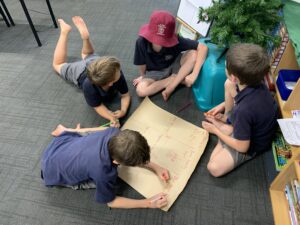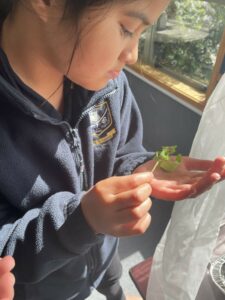Students at Ngāruawāhia Primary, St Paul’s Catholic and Ruawaro Combined Schools were given some very special and very hungry caterpillars to look after at the start of Term 4, 2022. The caterpillars are the larvae of the Honshu White Admiral butterfly (Limenitis glorifica) and are the natural predator of one of New Zealand’s most invasive pest plants – the Japanese honeysuckle (Lonicera japonica).
A suitcase of caterpillars
Entomologist and Senior Researcher, Hugh Gourlay at Manaaki Whenua- Landcare Research, has been studying and raising biological control agents (organisms that are natural predators to invasive species and introduced as a bio-control agent) for over 40 years and recently travelled from Lincoln in Canterbury to Waikato with a suitcase full of caterpillars and butterfly chrysalises to share with three classes.
This pilot project was initiated by Waikato District Council and Waikato Enviroschools and funded by the Waikato Regional Council’s Environmental Initiatives Fund to support hands-on learning in primary schools about insects as bio-control agents. The vision was that students would raise the Honshu butterflies and release them into local areas affected by Japanese honeysuckle.
Lessons on lifecycles
The project was a big learning curve for everyone. No school had previously been involved in raising these butterflies. Karangahake Valley near Paeroa, is the only site in New Zealand where the butterflies have successfully established in the wild after being intentionally released after the initial introduction into the country in 2014.

The Honshu butterflies in the classroom cage.
The lifecycle of the butterflies is about 8 weeks, so through the busy Term 4 of 2022 each class would hopefully raise a new generation of butterflies from the chrysalis and caterpillars supplied. That was the plan! In preparation for the care for the butterflies, facilitator Adrienne collected plant material (Japanese honeysuckle) and helped set up cages in the classroom.
Following the life cycle of these butterflies became an interesting process for the children, teachers and their Enviroschools facilitator alike. Children were fascinated watching these new butterflies as they emerged from their unusually shaped chrysalises. While trying to locate the tiny white pinhead-sized eggs and finding the well camouflaged larvae proved a real challenge, it really appealed to some students.
Isla at St Paul’s said, “I really enjoy learning about the butterflies and especially counting the eggs!”
Each class was given an observation recording sheet and copy of the Honshu life cycle to track how many larvae, butterflies and eggs were emerging over the course of the term. With tiny eggs, and numbers changing on an almost daily basis, it wasn’t an exact science, but the students in the class really got to hone their observation skills, learn in a hands-on way, and really understand exactly what the term ‘life cycle’ means.

Extra nutrition was provided for the butterflies from orange drink. Note the honey suckle flowers.
Each school initially received about 25 chrysalises. Students observed them closely and made sure that the butterflies, when they emerged, had enough to drink (orange E2 energy drink being their favourite when there were not enough honeysuckle flowers open). What surprised everyone was their short life span. Naturally the children were upset when the butterflies died and many of the children thought they were doing something wrong, but such is life for these fragile creatures.
“We learnt these butterflies don’t live very long – they only live 5-10 days; they lay eggs and then they die,” said students at Ngāruawāhia Primary School.
Facts of life, fertility and fluctuations
While it should be no surprise, the second interesting thing was that it takes both a male and female butterfly to mate and create fertile eggs. As educators, we are so used to seeing the classic circular process of the butterfly life cycle, that you could be forgiven for thinking that all you need is one butterfly to produce an egg – WRONG! We decided that something was clearly missing from the diagrams we had!

Counting the tiny eggs required sharp eyes.
Fertility can be affected by many factors – the number of butterflies, the light available and the temperature. While St Paul’s School counted about 17 eggs at one point, Ngāruawāhia had a peak total of about 12. After a lot of questioning, they realised that there was a 24 hour light on outside their classroom. When the students asked Hugh if this could impact the butterfly breeding, he said it was quite probable!
There were other temperature and light level fluctuations that could have been influencing the low numbers of eggs being laid. So, around week 7 of the term when there were still no new caterpillars, students were getting a little concerned and despondent. Then finally, in Week 8, Adrienne got emails from all 3 schools to say they have found caterpillars, and everyone breathed a sigh of relief – we had the next generation!
Losses, gains and other lessons
In Week 9, the last week of the school term, Adrienne visited both St Paul’s and Ngāruawahia Primary to reflect on the project with each class. Despite the losses, the children and teachers felt the project had been a success and had provided a wide range of learning experiences and there were many highlights for students and teachers. For students at Ngāruawahia Primary, these included “learning about the butterfly life cycle and seeing caterpillars grow and butterflies hatch and learning how to take care of the butterflies”.

Students observe a caterpillar as it starts to form a chrysalis.
Maddison at St Paul’s, “loved the look of the underpart of the butterflies and being able to look after the caterpillars and butterflies and that the cycle has carried on.”
Other students were excited at “finding our first caterpillar” and also “watching the butterflies develop it’s colours when it was hatching”; It was great that “we kept them alive, and it was great counting them”.
Curiosity was definitely sparked with this project and all classes wanted to continue trying to raise the butterflies in 2023. As part of the class reflection at St Paul’s, students wondered: “How do they come out of the chrysalis?”; “Can we learn about different species of caterpillars?”; “How butterflies get their patterns?” and “I wonder what their life would be like in the wild?”

St Paul’s students reflect on their experiences.
With the 2022/23 summer holidays looming and schools closing in Week 9 of Term 4, arrangements were made for teachers to look after the caterpillars and release butterflies in local patches of honeysuckle over the summer if they hatched. Unfortunately, despite being well looked after, this next generation didn’t survive the holidays. However, there were some wonderful learning experiences, and many of the students involved developed a deep curiosity about insects that would have never encountered otherwise.

Being careful with a caterpillar
Hugh explained that successful rearing of insects is a lot about a numbers game. Having a large number of insects makes it much easier to get more mating and more eggs, more larvae. However, this also means having a lot more plants and space, lighting, temperature control and management of all these factors. The white admiral (Honshu) is a reasonably easy insect to rear, although still quite fussy, but you still need a lot of plants and plant material, a lot of space for cages, plenty of time to feed and water plants and insects.
“These are all things that are easy for us here [Lincoln] but not so easy in a school setting. If the butterfly ever gets widely established in New Zealand, then collecting them from the local honeysuckle plants would be easy and much more manageable for a classroom rearing activity. It’s great that we got to interact with so many children and talk to them about insects and science, allow them to experience the insects first hand and see nature at its best. I really love doing this sort of thing and working with children”. – Hugh Gourlay, Senior Researcher, Manaaki Whenua-Landcare Research
For more information about this project and the Honshu Butterfly introduction as a bio-control agent see the links below.
Educating Our Youth with Honshu White Admiral Butterflies » Manaaki Whenua (landcareresearch.co.nz)
Honshu white admiral – Moths and Butterflies of New Zealand Trust (nzbutterflies.org.nz)